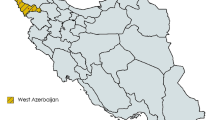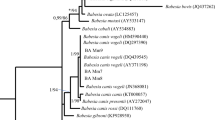Abstract
Coxiella burnetii can cause the zoonotic disease of Q fever, which has been observed in various species. Hyalomma aegyptium is a hard tick that undergoes its life cycle through three hosts. The spread of pathogens by Hyalomma aegyptium between different hosts can have significant epidemiological implications. The objective of this study was to detect the presence of C. burnetii in blood samples from turtles and H. aegyptium ticks attached to them in the northwest of Iran (Oshnavieh). A total of 500 engorged mature ticks and 100 blood samples were collected from 100 tortoises. Nested-PCR, using specific primers targeting the IS1111 and icd genes, was employed to diagnose C. burnetii. Out of the 100 tick pool samples, 10 were found to be infected with C. burnetii based on the IS1111 gene (10%; 95% CI, 5.5–17.4). The infection rate of C. burnetii in tick samples, as determined by the icd gene, was 6% (95% CI, 2.8–12.5). Furthermore, the infection rate of turtle blood with C. burnetii based on the IS1111 gene was 5% (95% CI, 2.2–11.2). The infection rate of the blood, as determined by the icd gene, was 3% (95% CI, 1–8.5). In conclusion, infected tortoises and H. aegyptium ticks carrying C. burnetii may play a role in transmitting this pathogenic agent to both humans and other animals. Therefore, it is essential to implement appropriate public health measures to reduce the circulation of the pathogen between various hosts.





Similar content being viewed by others
Availability of data and materials
The data are available from the corresponding author upon reasonable request.
References
Amin W, Ahmed S (2009) Detection of Coxiella burnetii in bovine milk samples using polymerase chain reaction. Assiut Vet Med J 55:1–9. https://doi.org/10.21608/AVMJ.2009.174925
Arricau-Bouvery N, Rodolakis A (2005) Is Q fever an emerging or re-emerging zoonosis? Vet Res 36:327–349. https://doi.org/10.1051/vetres:2005010
Aysul N, Kar S, Yılmazer N et al (2010) Prevalence of Hyalomma aegyptium (Lineaus, 1758) on tortoises (Testudo graeca) in Thrace. Etlik Vet Mikrobiyol Derg 37:53–56
Brianti E, Dantas-Torres F, Giannetto S et al (2010) Risk for the introduction of exotic ticks and pathogens into Italy through the illegal importation of tortoises, Testudo graeca. Med Vet Entomol 24:336–339. https://doi.org/10.1111/j.1365-2915.2010.00874.x
Celina SS, Cerný J (2022) Coxiella burnetii in ticks, livestock, pets and wildlife: a mini-review. Front Vet Sci 9:1068129. https://doi.org/10.3389/fvets.2022.1068129
Davis GE, Cox HR, Parker R (1938) A filter-passing infectious agent isolated from ticks. Public Health Rep 53:2259–2311. https://doi.org/10.2307/4582746
Davoust B, Marié J-L, de Santi VP et al (2014) Three-toed sloth as putative reservoir of Coxiella burnetii, Cayenne. French Guiana Emerg Infect Dis 20:1760. https://doi.org/10.3201/eid2010.140694
Duron O, Sidi-Boumedine K, Rousset E et al (2015) The importance of ticks in Q fever transmission: what has (and has not) been demonstrated? Trends Parasitol 31:536–552. https://doi.org/10.1016/j.pt.2015.06.014
Ebani VV, Mancianti F (2022) Potential role of birds in the epidemiology of Coxiella burnetii. Coxiella-like Agents and Hepatozoon Spp Pathog 11:298. https://doi.org/10.3390/pathogens11030298
Eldin C, Mélenotte C, Mediannikov O et al (2017) From Q fever to Coxiella burnetii infection: a paradigm change. Clin Microbiol Rev 30:115–190. https://doi.org/10.1128/CMR.00045-16
Ereqat S, Nasereddin A, Al-Jawabreh A et al (2016) Molecular detection and identification of spotted fever group rickettsiae in ticks collected from the West Bank. Palestinian Territories Plos Negl Trop Dis 10:e0004348. https://doi.org/10.1371/journal.pntd.0004348
Esmaeili S, Mohabati Mobarez A, Khalili M et al (2019) Molecular prevalence of Coxiella burnetii in milk in Iran: a systematic review and meta-analysis. Trop Anim Health Prod 51:1345–1355. https://doi.org/10.1007/s11250-019-01807-3
Fenga C, Gangemi S, De Luca A et al (2015) Seroprevalence and occupational risk survey for Coxiella burnetii among exposed workers in Sicily, Southern Italy. Int J Occup Environ Health 28:901–907. https://doi.org/10.13075/ijomeh.1896.00448
Gargili A, Estrada-Peña A, Spengler JR et al (2017) The role of ticks in the maintenance and transmission of Crimean-Congo hemorrhagic fever virus: a review of published field and laboratory studies. Antiviral Res 144:93–119. https://doi.org/10.1016/j.antiviral.2017.05.010
Gharbi M, Rjeibi MR, Rouatbi M et al (2015) Infestation of the spur-thighed tortoise (Testudo graeca) by Hyalomma aegyptium in Tunisia. Ticks Tick Borne Dis 6:352–355. https://doi.org/10.1016/j.ttbdis.2015.02.009
González-Barrio D, Ruiz-Fons F (2019) Coxiella burnetii in wild mammals: a systematic review. Transbound Emerg Dis 66:662–671. https://doi.org/10.1111/tbed.13085
González J, González MG, Valcárcel F et al (2020a) Prevalence of Coxiella burnetii (Legionellales: Coxiellaceae) infection among wildlife species and the tick Hyalomma lusitanicum (Acari: Ixodidae) in a Meso-Mediterranean ecosystem. J Med Entomol 57:551–556. https://doi.org/10.1093/jme/tjz169
González J, González MG, Valcárcel F et al (2020b) Transstadial transmission from nymph to adult of Coxiella burnetii by naturally infected Hyalomma lusitanicum. Pathog 9:884. https://doi.org/10.3390/pathogens9110884
González J, Valcárcel F, Aguilar A et al (2017) In vitro feeding of Hyalomma lusitanicum ticks on artificial membranes. Exp Appl Acarol 72:449–459. https://doi.org/10.1007/s10493-017-0167-1
Harrus S, Baneth G (2005) Drivers for the emergence and re-emergence of vector-borne protozoal and bacterial diseases. Int J Parasitol 35:1309–1318. https://doi.org/10.1016/j.ijpara.2005.06.005
Huang J, Wang R, Gao C et al (2021) A case of tick-transmitted Q fever in Lishui, China diagnosed by next-generation sequencing. J Int Med Res 49:3000605211025398. https://doi.org/10.1177/03000605211025398
Kazimírová M, Hamšíková Z, Špitalská E et al (2018) Diverse tick-borne microorganisms identified in free-living ungulates in Slovakia. Parasit Vectors 11:1–18. https://doi.org/10.1186/s13071-018-3068-1
Khademi P, Ownagh A, Ataei B et al (2020) Prevalence of C. burnetii DNA in sheep and goats milk in the northwest of Iran. Int J Food Microbiol 331:108716. https://doi.org/10.1016/j.ijfoodmicro.2020.108716
Khoobdel M, Jafari A, Telmadarraiy Z et al (2021) Tick-borne pathogens in Iran: a meta-analysis. Asian Pac J Trop Med 14:486–504. https://doi.org/10.4103/1995-7645.329009
Klee SR, Tyczka J, Ellerbrok H et al (2006) Highly sensitive real-time PCR for specific detection and quantification of Coxiella burnetii. BMC Microbiol 6:1–8. https://doi.org/10.1186/1471-2180-6-2
Körner S, Makert GR, Mertens-Scholz K et al (2020) Uptake and fecal excretion of Coxiella burnetii by Ixodes ricinus and Dermacentor marginatus ticks. Parasit Vectors 13:1–11. https://doi.org/10.1186/s13071-020-3956-z
Körner S, Makert GR, Ulbert S et al (2021) The prevalence of Coxiella Burnetii in hard ticks in Europe and their role in Q fever transmission revisited a systematic review. Front Vet Sci 8:655715. https://doi.org/10.3389/fvets.2021.655715
Kröber T, Guerin PM (2007) In vitro feeding assays for hard ticks. Trends Parasitol 23:445–449. https://doi.org/10.1016/j.pt.2007.07.010
Lapointe J-M, Gulland FM, Haines DM (1999) Placentitis due to Coxiella burnetii in a Pacific harbor seal (Phoca vitulina richardsi). J Vet Diagn Invest 11:541–543. https://doi.org/10.1177/104063879901100612
López-Olvera JR, Vidal D et al (2009) Serological survey of selected infectious diseases in mouflon (Ovis aries musimon) from south-central Spain. Eur J Wildl Res 55:75–79. https://doi.org/10.1007/s10344-008-0215-6
Meredith A, Cleaveland S, Denwood M et al (2015) Coxiella burnetii (Q-Fever) Seroprevalence in prey and predators in the United Kingdom: evaluation of infection in wild rodents, foxes and domestic cats using a modified ELISA. Transbound Emerg Dis 62:639–649. https://doi.org/10.1111/tbed.12211
Mihalca AD, Gherman CM, Cozma V (2011) Coendangered hard-ticks: threatened or threatening? Parasit Vectors 4:1–7. https://doi.org/10.1186/1756-3305-4-71
Mobarez AM, Mostafavi E, Khalili M et al (2021) Identification of Coxiella burnetii in Raw Milk of Livestock Animal in Iran. Int J Microbiol 2021:6632036. https://doi.org/10.1155/2021/6632036
Najjar C, Kaabi B, Younsi H (2020) Ticks parasitizing the Spur-thighed tortoise (Testudo graeca) population of Tunisia. J Wildl Dis 56:815–822. https://doi.org/10.7589/2019-09-219
Parisi A, Fraccalvieri R, Cafiero M et al (2006) Diagnosis of Coxiella burnetii related abortion in Italian domestic ruminants using single-tube nested PCR. Vete Microbiol 118:101–106. https://doi.org/10.1016/j.vetmic.2006.06.023
Paștiu AI, Matei IA, Mihalca AD et al (2012) Zoonotic pathogens associated with Hyalomma aegyptium in endangered tortoises: evidence for host-switching behaviour in ticks? Parasit Vectors 5:1–6. https://doi.org/10.1186/1756-3305-5-301
Pilloux L, Baumgartner A, Jaton K et al (2019) Prevalence of Anaplasma phagocytophilum and Coxiella burnetii in Ixodes ricinus ticks in Switzerland: an underestimated epidemiologic risk. New Microbes New Infect 27:22–26. https://doi.org/10.1016/j.nmni.2018.08.017
Rehácek J, Brezina R (1968) Detection of Coxiella burnetii in saliva of experimentally infected ticks, Hyalomma dromedarii Koch. Bull World Health Organ 39:974. PMID: 5306113
Rizzoli A, Hauffe HC, Carpi G et al (2011) Lyme Borreliosis in Europe Eurosurveillance 16:19906
Ruiz-Fons F, Rodríguez Ó, Torina A et al (2008) Prevalence of Coxiella burnetti infection in wild and farmed ungulates. Vet Microbiol 126:282–286. https://doi.org/10.1016/j.vetmic.2007.06.020
Sander WE, King R, Graser W et al (2021) Coxiella burnetii in 3 species of turtles in the upper midwest. United States Emerg Infect Dis 27:3199. https://doi.org/10.3201/eid2712.211278
Široký P, Kubelová M, Modrý D et al (2010) Tortoise tick Hyalomma aegyptium as long term carrier of Q fever agent Coxiella burnetii evidence from experimental infection. Parasitol Res 107:1515–1520. https://doi.org/10.1007/s00436-010-2037-1
Smith D (1940) Studies in the epidemiology of Q fever 3. The teransmission of Q fever by the tick Haemaphysalis humerosa. Aust J Exp Biol Med Sci 18(2):103–118. https://doi.org/10.1038/icb.1940.11
Smith D (1941) Studies in the epidemiology of Q fever 8. The teransmission of Q fever by the tick Rhipicephalus sanguineus. Aust J Exp Biol Med Sci 19(2): 133–136. https://doi.org/10.1038/icb.1941.21.23
Smith D (1942) Studies in the Epidemiology of Q Fever. 11. Experimental Infection of the Ticks Haemaphysalis bispinosa and Ornithodorus. sc. with Rickettsia burneti. Aust J Exp Biol Med Sci 20:295–296. https://doi.org/10.1038/icb.1942.4724
Stevenson S, Gowardman J, Tozer S et al (2015) Life-threatening Q fever infection following exposure to kangaroos and wallabies. BMJ Case Rep 2015:bcr2015210808. https://doi.org/10.1136/bcr-2015-210808
To H, Sakai R, Shirota K et al (1998) Coxiellosis in domestic and wild birds from Japan. J Wildl Dis 34:310–316. https://doi.org/10.7589/0090-3558-34.2.310
Acknowledgements
Mr. Kazemnia’s, Mr. Pirnejad’s, and Mr. Badali’s technical assistance and the teams of the Microbiology Laboratory and Parasitology were also highly appreciated.
Funding
The authors would like to thank the Vice-Chancellor for Research and Technology at Urmia University for funding the PostDoc project (D10/647).
Author information
Authors and Affiliations
Contributions
Study concept and design: PK and AT. Sample preparation: PK, AT and AE. Molecular assay and interpretation of data: PK, AT and AO. Writing-original draft preparation: PK, AT and AO. Writing- review & editing: MH.
Corresponding author
Ethics declarations
Ethics approval and consent to participate
All procedures in this study were conducted in accordance with the Veterinary Ethics Committee of the Faculty of Veterinary Medicine of Urmia University (IRUU-AEC-211/DA6/01/09/2022) and approved all protocols used in the present study.
Competing interests
The authors declare that they have no conflicts of interest. All authors have full control over the primary data and agree to allow the review of their data upon request.
Additional information
Publisher's Note
Springer Nature remains neutral with regard to jurisdictional claims in published maps and institutional affiliations.
Rights and permissions
Springer Nature or its licensor (e.g. a society or other partner) holds exclusive rights to this article under a publishing agreement with the author(s) or other rightsholder(s); author self-archiving of the accepted manuscript version of this article is solely governed by the terms of such publishing agreement and applicable law.
About this article
Cite this article
Khademi, P., Tukmechi, A., Ownagh, A. et al. Molecular detection of Coxiella burnetii in blood samples of turtles (Testudo graeca) and their associated ticks. Eur J Wildl Res 69, 116 (2023). https://doi.org/10.1007/s10344-023-01747-2
Received:
Revised:
Accepted:
Published:
DOI: https://doi.org/10.1007/s10344-023-01747-2




